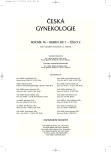Extended embryo culture in IVF does not improve pregnancy rate
Authors:
J. Pavelková; K. Řežábek; Martina Moosová; M. Světlíková
Authors‘ workplace:
Centrum asistované reprodukce Apolinář, Gynekologicko-porodnická klinika 1. LF UK a VFN, Praha, přednosta prof. MUDr. A. Martan, DrSc.
Published in:
Ceska Gynekol 2011; 76(2): 120-123
Overview
Objective:
Compare the effectiveness of the IVF extended embryo culture day 4 versus day 2.
Design:
Retrospective analysis.
Setting:
Assisted Reproduction centre Apolinar, Department of Obstetrics and Gynecology, 1st Faculty of Medicine, Charles University and General Faculty Hospital in Prague.
Methods:
We compared pregnancy rate (PR) and implantation rate (IR) of all IVF and IVF/ICSI embryo transfers (ET) performed between August 2004 and July 2008, in which 2 embryos were transfered. All transfers were done by the same physician. Maternal age was ≤ 35 years (from 22 to 35 years, mean 30.4 years, median 31.1 years). The group of embryos evaluated and transfered on the day 2 was compared with the embryos evaluated and transfered on the day 4. Based on the evaluation, each embryo was assigned to one of the following categories: Grade A (top quality embryo) or grade B (medium quality embryo).
Results:
On the day 2, ET of A+A embryos led to PR 69.0%; A+B 53.3% and B+B 36.4% (IR 50.0%, 40.0% and 22.7%), where number of transfers was 42, 30 and 11 in every group. On the day 4, ET of A+A embryos led to PR 54.3%, A+B 48.7%, B+B 26.6% (IR 45.6%, 34.6%, 13.3%), where number of transfers was 46.39 and 15 in every group.
Conclusion:
In our group, we found no statistical significant difference (p<0.05) in PR between day 2 and day 4 embryotransfers. Results of the day 2 transfers have a trend to be better than results of day 4 transfers.
Regardless of the transfer day, the prognosis of grade A embryos was significantly better (p<0.05) than for grade B embryos.
Key words:
IVF, early cleavage embryo transfer, day 4 embryo transfer, extended culture, pregnancy rate, implantation rate.
Sources
1. Ambartsumyan, G., Clark, AT. Aneuploidy and early human embryo development. Hum Mol Genet, 2008, 15, 17(R1), R 10‑15.
2. Blake, D., Proctor, M., Johnson, N., Olive, D. Cleavage stage versus blastocyst stage embryo transfer in assisted conception. Cochrane Database Syst Rev, 2005, 19, 4, CD002118.
3. Braude, P., Bolton, V., Moor, S. Human gene expression first occurs between the four - and eight-cell stages of preimplantation development. Nature, 1988, 332, p. 459-460.
4. Farfalli, V., Magli, MC., Ferraretti, AP., Gianaroli, L. Role of aneuploidy on embryo implantation. Gynecol Obstet Invest, 2007, 64, 3, p. 161-165.
5. Feil, D., Henshaw, RC., Lane, M. Day 4 embryo selection is equal to Day 5 using a new embryo scoring system validated in single embryo transfers. Hum Reprod, 2008, 23, 7, p. 1505-1510.
6. Gardner, DK. Development of serum-free media for culture and transfer of human blastocyst. Hum Reprod, 1998, 13, 4, p. 218‑225.
7. Koryntova, D., Moosova, M., Rezabek, K., et al. Single embryo transfer does not kompromise the pregnancy rate in patiens with good IVF/ICSI prognosis. Ces Gynek, 2005, 70, 6, s. 435-439.
8. Kovacs, P., Matyas, S., Kaali, SG. Embryo selection or uterine environment: Which plasy grater role in blastocyst transfer cycles? J Obstet Gynaecol Res., 2010, Nov 28, Epub ahead of print.
9. Magli, MC., Gianaroli, L., Ferraretti, AP., et al. Embryo morphology and development are dependent on the chromosomal complement. Fertil Steril, 2007, 87, 3, p. 534-541.
10. Margreiter, M., Weghofer, A., Kogosowski, A., et al. A prospective randomized multicenter study to evaluate the best day for embryo transfer: does the outcome justify prolonged embryo culture? J Assist Reprod Genet, 2003, 20, p. 91-94.
11. Meintjes, M., Chantilis, SJ., Ward, DC., et al. A randomized controlled study of human serum albumin and serum substitute suplement as protein supplements for IVF culture and the effect on live birth rates. Hum Reprod, 2009, 24, 4, p. 782-789.
12. Papanikolaou, EG., Camus, M., Kolibianakis, EM., et al. In vitro fertilization with single blastocyst-stage versus single cleavage-stage embryos. N Engl J Med, 2008, 16, 354(11), p. 1139-1146.
13. Paternot, G., Devroe, J., Debrock, S., et al. Intra - and inter-observer analysis in the morphological assessment of early-stage embryos. Reprod Biol Endocrinol, 2009, 29, 7, p. 105.
14. Sills, ES., Palermo, GD. Human blastocyst culture in IVF: current laboratory applications in reproductive medicine practise. Rom J Morphol Embryol, 2010, 51, 3, p. 441-445.
15. Tao, J., Tamis, R., Fink, K., et al. The neglected morula/compact stage embryo transfer. Hum Reprod, 2002, 17, 6, p. 1513-1518.
16. Wirleitner, B., Vanderzsalmen, P., Stecher, A., et al. Individual dement of human embryos on IVF culture medium: influence on blastocyst development and pregnancy outcome. Reprod Biomed Online, 2010, 21, 6, p. 776-782.
Labels
Paediatric gynaecology Gynaecology and obstetrics Reproduction medicineArticle was published in
Czech Gynaecology

2011 Issue 2
Most read in this issue
- Extended embryo culture in IVF does not improve pregnancy rate
- Uterine fibroids and their treatment
- Luteal support in the IVF/ET programme
- Decreased fertility and today’s possibility of examination in reproductive immunology
